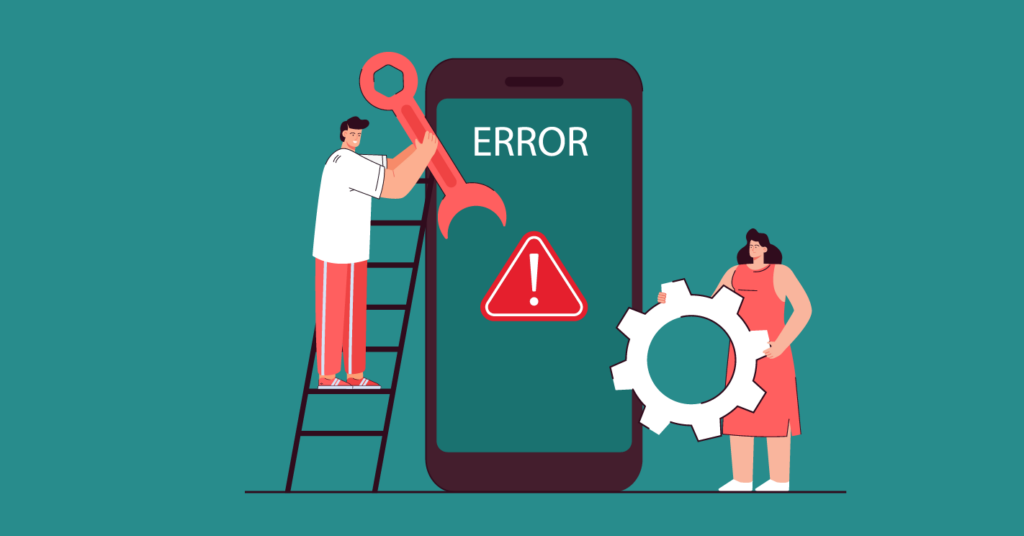Table Of Content
- Mobile App Crashes Defined
- Causes of Mobile App Crashes
- How to Fix Mobile App Crashes
- Empowering Users: Essential Practices for App Stability
- Avoid App Crashes with KPI Monitoring
- Build a Crash-Free App with Krasamo
Mobile applications have become integral to the digital experience, offering users various functionalities ranging from simple utilities to complex platforms for business, entertainment, and social interaction.
However, the smooth operation of these apps is crucial to maintaining user engagement and satisfaction. App crashes freezes, and slow loadings significantly detract from the user experience, leading to frustration and decreasing user retention and engagement.
Improving crash rates and ensuring the application performs optimally are directly linked to better business outcomes. High-performing apps enjoy higher user satisfaction, leading to increased downloads, higher engagement rates, positive reviews, and improved app store rankings.
These factors collectively drive business results by enhancing discoverability, attracting new users, and retaining existing ones. Moreover, users are more likely to engage in in-app purchases and recommend the app to others if they have a positive experience, further driving revenue and growth.
Effective mobile performance monitoring and management are pivotal in solving app crashing issues. By implementing a robust monitoring system, developers can gain real-time insights into the app’s performance, identify and diagnose the root causes of crashes, freezes, or lags, and take corrective actions before these issues impact the user experience.
Mobile App Crashes Defined
Mobile app crashes are unexpected terminations of a mobile application while running. These crashes can occur for various reasons, including but not limited to software bugs, compatibility issues, hardware malfunctions, or insufficient system resources. When an app crashes, it usually closes suddenly, and the user may lose unsaved data, experience a disruption in their activity, or notice an error message.
Causes of Mobile App Crashes
- Software Bugs: Errors in the app’s code can lead to crashes during specific interactions or under certain conditions.
- Compatibility Issues: Apps may crash if they are not fully compatible with the operating system version or the mobile device’s hardware.
- Memory Leaks: Improper memory management can cause the app to consume excessive resources, leading to crashes.
- Insufficient Testing: Inadequate testing across different devices and OS versions can leave bugs undetected.
- Third-Party Services: Failures or changes in APIs and services the app relies on can cause crashes.
- User Inputs: Unexpected user inputs or interactions that the developers did not anticipate can lead to errors that cause crashes.
- Hardware Issues: Faults in the device’s hardware, such as a failing memory chip, can also result in app crashes.
How to Fix Mobile App Crashes
Fixing mobile app crashes is a multifaceted challenge for developers, requiring them to identify root causes, ensure device compatibility, and manage system resources effectively. Here are streamlined strategies to address these challenges:
- Identifying the Cause: App crashes can arise from code bugs, hardware issues, or external dependencies. Using debugging tools like those in Android Studio and Xcode can help trace these crashes, though intermittent ones under unique conditions may be particularly tricky to pinpoint.
- Monitoring and Logging: Implement error logging and monitoring with tools like Firebase Crashlytics to collect and analyze crash data, essential for real-time crash identification and tracking.
- Updating Dependencies and OS Compatibility: Regularly update all libraries and dependencies to match the latest OS versions. Adapt to mobile operating system updates that introduce new APIs and phase out old ones to prevent crashes due to compatibility issues.
- Managing Third-Party Components: Since many apps rely on external libraries and APIs, ensure these components are stable and up-to-date. Developers must navigate the challenges of external dependencies cautiously, as they can introduce bugs or become deprecated.
- Device Diversity: The wide variety of mobile devices with different hardware and OS versions necessitates extensive testing to ensure smooth app performance across all platforms and prevent device-specific crashes.
- Optimizing Resource Use: Efficient memory and CPU usage are critical to prevent crashes from memory leaks or overconsumption. Proper memory management and performance optimization are crucial, especially in resource-constrained environments or for data-intensive apps.
- Comprehensive Testing: Conduct thorough testing across multiple devices and OS versions to uncover and rectify potential crash causes. While exhaustive testing is challenging, it’s essential for catching and addressing issues pre-release.
- Exception Handling and User Input Management: Implement robust exception handling to manage unexpected errors gracefully. Anticipate a range of user inputs and interactions to prevent crashes due to unforeseen behaviors.
- Concurrency Management: Correctly manage concurrent operations and asynchronous code to avoid issues like race conditions, deadlocks, or crashes in complex data processing or resource-intensive applications.
- Engaging Users for Feedback: Encourage user feedback and utilize automated crash reporting tools to gather insights on crashes from real-world use. This feedback is invaluable for diagnosing issues not caught during testing.
By focusing on these strategies, developers can tackle the most significant challenges in fixing app crashes, enhancing app stability, and providing a better user experience.
To overcome these challenges, developers use various tools and practices, including automated testing frameworks, continuous integration and deployment pipelines, crash analytics platforms, and user feedback channels. Despite these efforts, achieving a completely crash-free app is extremely challenging, highlighting the importance of ongoing maintenance, app monitoring, and user support.
Empowering Users: Essential Practices for App Stability
While developers work diligently to ensure their apps are stable and efficient, the role of users in maintaining this stability cannot be overstated. Users significantly contribute to their favorite apps’ seamless performance through specific, proactive actions, reinforcing the collaborative effort needed for optimal app functionality.
- Update the App: Ensure that the app is updated to the latest version, as updates often include fixes for known issues.
- Restart the Device: Sometimes, simply restarting the mobile device can resolve underlying issues causing the app to crash.
- Clear App Cache/Data: Clearing the app’s cache or data can fix crashes related to corrupted cache or settings (note: this might result in loss of saved data within the app).
- Reinstall the App: Uninstalling and reinstalling the app can sometimes resolve persistent crash issues.
- Update the Device OS: Updating the operating system can resolve compatibility issues that lead to crashes.
- Contact Support: If the issue persists, contact the app’s support team for assistance or to report the crash.
Addressing mobile app crashes effectively requires a combination of proactive, agile development practices, thorough testing, and responsive user support to ensure a smooth and stable user experience.
Avoid App Crashes with KPI Monitoring
To overcome these challenges, developers use various tools and practices, including automated testing frameworks, continuous integration and deployment pipelines, crash analytics platforms, and user feedback channels. Despite these efforts, achieving a completely crash-free app is extremely challenging, highlighting the importance of ongoing maintenance, monitoring, and user support.
Mobile app developers must tackle complex app quality issues before negatively affecting your app’s discoverability rankings in app stores. To address these and other quality issues effectively, developers should monitor several key performance metrics that impact user experience and app stability. Here are the essential metrics to track:
- Crash Rates: The frequency at which the app crashes during a certain period or number of sessions. This metric helps identify the app’s stability and is critical for understanding its reliability.
- Application Not Responding (ANR Rates): The frequency of ANR events where the app is unresponsive for a certain period, usually more than 5 seconds. Tracking ANRs is crucial because they directly affect user experience and app store ratings.
- Startup Time: The time it takes for the app to launch and become usable. Slow startup times can frustrate users and lead to negative reviews, affecting app discoverability.
- Memory Usage: How much memory the app uses during operation. Excessive memory use can lead to crashes, ANRs, and poor device performance, especially on devices with limited resources.
- CPU Usage: Monitoring CPU consumption is essential for understanding the app’s impact on performance. High CPU usage can cause the app to slow down, drain the battery rapidly, and increase device temperature.
- Network Requests and Latency: The number and efficiency of network requests made by the app, along with their response times. Optimizing network usage is key to ensuring smooth app performance, especially in data-intensive applications.
- Battery Usage: How much battery does the app consume? Apps that drain the battery quickly can lead to negative user experiences and reviews.
- Frame Rate: The smoothness of animations and transitions within the app. A low or inconsistent frame rate can make the app appear sluggish and unresponsive.
- Disk Usage: The amount of disk space the app uses for storage. Excessive disk usage can affect the app’s performance and limit space available for other apps and data.
- Error Rates: The frequency of errors encountered during the app’s operation, including handled and unhandled exceptions. Tracking error rates helps identify areas of the app that need improvement.
- User Engagement Metrics: Metrics like daily active users (DAU), session length, and retention rates offer insights into how users interact with the app, which can indirectly influence its quality and stability.
- Feedback and Ratings: User feedback and ratings in app stores provide qualitative insights into user experiences and satisfaction levels, highlighting areas for improvement.
By monitoring these metrics, developers can identify and address issues that affect app quality, performance, and user satisfaction. Tools like Google’s Firebase, Apple’s Xcode Instruments, and various third-party analytics services can help track these metrics, allowing developers to make informed decisions to enhance app quality and maintain high discoverability in app stores.
Build a Crash-Free App with Krasamo
Once an organization invests in building a mobile application, it is important to have the right team managing and monitoring the app and maintenance practices to keep it crash-free. Contact a Krasamo mobile engineer to consult about your specific use case and learn about our approach to mobile app development.












